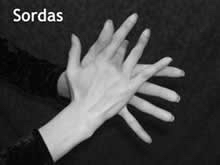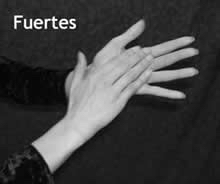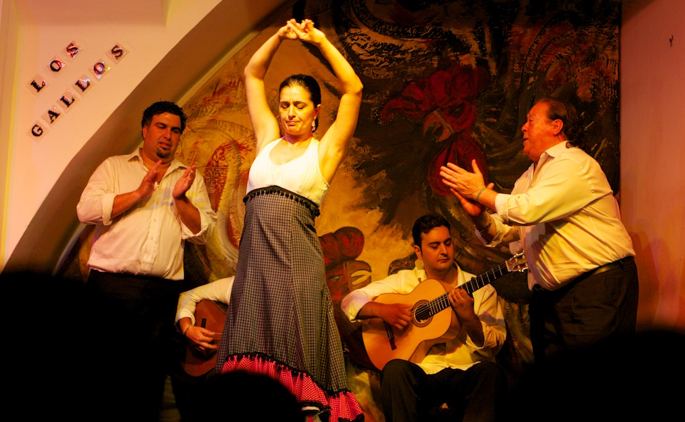When I first began studying Flamenco dance, I had no idea how important or difficult Palmas (the Flamenco term for hand clapping) could be. What seemed at the time like a simple task soon unfolded in its full complexity as I clumsily galloped my way from Rubina Carmona’s basic level dance classes into intermediate classes and beyond.
There’s not a week that goes by where I don’t think about how fortunate we (Rubina’s students) are to have the rare luxury of live guitar and singing accompaniment for our upper level classes and Peña rehearsals. In the basic classes with recorded music, I took the steady synthesized palmas or electronic beats for granted. In classes with live music, I soon found out that contributing just a small fraction to the overall organic pulse of the accompaniment with palmas was a huge responsibility.
Why Practice Palmas?
Clapping hands may seem like a silly thing to practice. Most of us have known how to do this simple task since we were children. The challenge begins when you vary the technique to create different sounds, keep a consistent sound, stay on a steady beat, stay on a steady counter beat, and then move your body, sing, or provide jaleo (encouraging shouts to performers) while doing it all.
When you’re the only one providing palmas, there is incredible pressure to stay meticulously on the beat and not be thrown off by what is happening in the cante (singing), toque (guitar playing), or zapateado (dancer’s footwork). When you’re a palmero/palmista you’re the human metronome and the support for the whole ensemble – you’re an anchor and you’re the strong roots of a tree, even though your role may seem trivial to the unknowing eye.
When you’re among a group of palmeros/palmistas, strive to make a dozen hands clapping sound like one very loud, voluminous palmas player. Try to synchronize with your fellow rhythm keepers to a fraction of a second. It only takes one person to throw off the rhythm of a group, especially with live music.
It’s easy to daydream and go on autopilot with palmas and not even realize that your rhythm is off. It’s easy to get sympathetically sucked into the sound of a counter rhythm that the dancer may be making with their footwork. It’s easy to get so excited by the amazing spirit of dancing, singing, or guitar that you instinctively speed up and lose your awareness of the steady beat that your fellow anchors are maintaining. Always remember to be conscious of your compas when working with other artists. Rhythmically zone in, synch-up, and be accountable.
Two Basic Palmas Techniques
Palmas Sordas (Muted)
 Palmas Sordas, also called Palmas Bajas (Low), create a muffled sound achieved by cupping the palms while spreading and extending the fingers. Hands should be at a slight diagonal to each other. I like to line up my left thumb between my right index and middle finger.
Palmas Sordas, also called Palmas Bajas (Low), create a muffled sound achieved by cupping the palms while spreading and extending the fingers. Hands should be at a slight diagonal to each other. I like to line up my left thumb between my right index and middle finger.
Palmas Fuertes (Strong)
 Palmas Fuertes, also called Palmas Claras (clear) or Altas (high), create a crisp, loud sound achieved by hitting the flattened fingers of the right hand on the palm of the left hand. It helps to have fingers slightly extended so that there is a slight cup to the palm of the left hand. This one is more difficult and takes a lot of practice to produce a consistent sound.
Palmas Fuertes, also called Palmas Claras (clear) or Altas (high), create a crisp, loud sound achieved by hitting the flattened fingers of the right hand on the palm of the left hand. It helps to have fingers slightly extended so that there is a slight cup to the palm of the left hand. This one is more difficult and takes a lot of practice to produce a consistent sound.
In whatever capacity you’re involved in Flamenco, you can never practice palmas enough. Palmas are an incredible resource for deepening your understanding and intuition for rhythm. It’s my theory that playing rhythm with the hands intensifies the rhythmic learning process due to the extra sensitivity of the hands and the number of nerve endings on the palms and fingers. For example, think of the painful misery that a paper-cut or hangnail causes in comparison to a scratch on your arm. A paper cut can cause you agony for days, while a scratch on the arm is forgotten after a few minutes. Even if you don’t foresee yourself in a situation where you’ll be doing palmas, practice anyway and practice often.
How to Practice Palmas
Find a rhythm-heavy 4/4 song (like rumbas or tangos) or use a metronome to practice with. There’s a bounty of Solo Compas recordings on iTunes if you’re looking for a good place to start or you can use one of the flamenco metronomes here at Ravenna Flamenco.
Now practice the following: Alternate with 8 sordas then 8 fuertes, on the beat at a slow comfortable pace for the whole song. Go at half time, quarter time if you need to. The quality and consistency of the tone you create is far more important than speed. Once you’ve mastered the whole song, double the speed of your palmas, and so on and so forth. It may take a few weeks to get up to a fast pace.
Using the same method, try clapping in between the beat (contratiempo) starting at the same slow pace, increasing speed accordingly. Focus on rhythmic precision, consistency and quality of sound. Once you’ve mastered that, it’s time to multitask by adding jaleo or a basic foot pattern with both on- and off-beat versions. Try an “olé” or single stamp, tap, or heel with the foot on every downbeat.
For an added challenge try a more complex foot pattern. First, a basic walk (shifting weight and stepping right then left) at quarter time, then half time, etc. Also try a Step-Touch (stepping right then left, but shifting weight on every other step).
Once you’re comfortable with 4/4, add different palos and tempos to your repertoire. Alegrias and Sevillanas are both excellent places to begin working with triplet times. In each of these cases, use the same method as above: start slow (at half or quarter time) and increase speed only when your tone is consistent. Once you have the basic rhythm, try contratiempo (clapping between the beats) and other rhythmic variations. As is always the case with flamenco, listen to and watch as much as you possibly can. A little bit of consistent attention over time pays off in spades when you find yourself among other musicians and dancers.

